

Louis Kahn - My Architect: A Son Journey (Subtitulada español) Peter Eisenman. Mies van der Rohe's Farnsworth House (1 of 3) Mies van der Rohe - Visions Of Space 1/7 (Less is More) VernissageTV on blip.tv. Architecture Le Corbusier. Le corbusier - home. Of this we are sure. Annie weighs in with an astute observation on the work of SANAA: Nishizawa used the term 'atmosphere' over and over again.
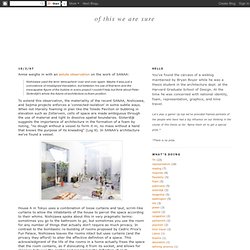
Maybe it was just a coincidence of misaligned translation, but between his use of that term and the inescapable figure of the bubble in every project I couldn't help but think about Peter Sloterdijk's whole the-future-of-architecture-is-foam position. To extend this observation, the materiality of the recent SANAA, Nishizawa, and Sejima projects enforces a 'connected-isolation' in some subtle ways. When not literally foaming in plan like the Toledo Pavilion or bubbling in elevation such as Zollervein, cells of space are made ambiguous through the use of material and light to dissolve spatial boundaries. Sloterdijk suggests the importance of architecture in the formation of a foam by noting, "no dough without a vessel to form it in; no mass without a hand that knows the purpose of its kneading" (Log 9). SANAA: Falling Upwards. On first glance the eye rushes to analyze, it strives to comprehend objects, composition and meaning.

In the foray into visual ordering and synaptic response the eye is lead astray. Look again; objects disappear, expand, melt, figures are juxtaposed as objects; recognizable elements are left indescribable, rendered multiple and disoriented. The eye is left to contemplate a rich fabric of improbabilities and sequential alternations. At the point of recognition, the composition is thrust into a state of destabilized visual flux. Visual cues bring forth memories and associations, and yet it is precisely when these associations are made that the eye is met with a multitude of matches. Architecture. Brunelleschi, in the building of the dome of Florence Cathedral in the early 15th-century, not only transformed the building and the city, but also the role and status of the architect.[1][2] Architecture (Latin architectura, after the Greek ἀρχιτέκτων – arkhitekton – from ἀρχι- "chief" and τέκτων "builder, carpenter, mason") is both the process and the product of planning, designing, and constructing buildings and other physical structures.
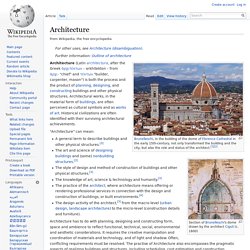
Architectural works, in the material form of buildings, are often perceived as cultural symbols and as works of art. Historical civilizations are often identified with their surviving architectural achievements. "Architecture" can mean: Architecture has to do with planning, designing and constructing form, space and ambience to reflect functional, technical, social, environmental and aesthetic considerations. The word "architecture" has also been adopted to describe other designed systems, especially in information technology.[3] History[edit] Architecture criticism. Architecture criticism is a confused topic.
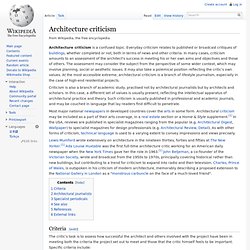
Everyday criticism relates to published or broadcast critiques of buildings, whether completed or not, both in terms of news and other criteria. In many cases, criticism amounts to an assessment of the architect's success in meeting his or her own aims and objectives and those of others. The assessment may consider the subject from the perspective of some wider context, which may involve planning, social or aesthetic issues.
It may also take a polemical position reflecting the critic's own values. At the most accessible extreme, architectural criticism is a branch of lifestyle journalism, especially in the case of high-end residential projects. Criticism is also a branch of academic study, practised not by architectural journalists but by architects and scholars. Criteria[edit] Architectural journalists[edit] Contemporary critics working for major newspapers include: Specialist periodicals[edit] List of architecture magazines See also[edit] History of architecture. The Architect's Dream by Thomas Cole (1840) shows a vision of buildings in the historical styles of the Western tradition, from Ancient Egypt through to Classical Revival A view of Chuo-ku, Osaka, Japan showing buildings of a modern Asian city, ranging from the medieval Osaka Castle to skyscrapers.
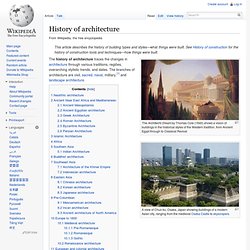
Architectural theory. Architectural theory is the act of thinking, discussing, and writing about architecture.
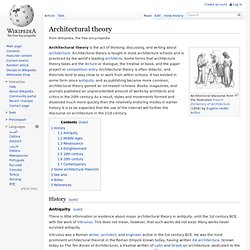
Architectural theory is taught in most architecture schools and is practiced by the world's leading architects. Some forms that architecture theory takes are the lecture or dialogue, the treatise or book, and the paper project or competition entry. Architectural theory is often didactic, and theorists tend to stay close to or work from within schools. It has existed in some form since antiquity, and as publishing became more common, architectural theory gained an increased richness.